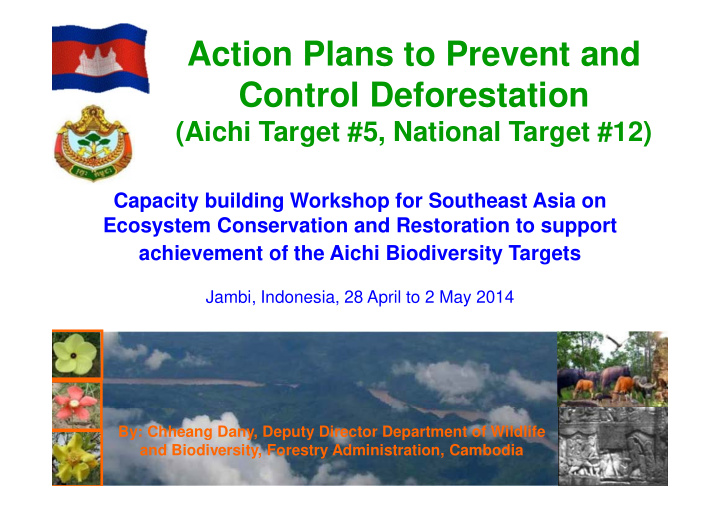



Action Plans to Prevent and Control Deforestation (Aichi Target #5, National Target #12) Capacity building Workshop for Southeast Asia on Ecosystem Conservation and Restoration to support achievement of the Aichi Biodiversity Targets Jambi, Indonesia, 28 April to 2 May 2014 By: Chheang Dany, Deputy Director Department of Wildlife and Biodiversity, Forestry Administration, Cambodia
Outline • Back Ground and Introduction • Action Plans to Prevent and Control Deforestation
Introduction Cambodia Is part of Indo-Burma Biodiversity Hotspot of 25 Global hotspots, it have the largest remaining extensive intact block of a unique landscape of exceptional global importance for biodiversity conservation, habitats for thousand species of wildlife species and climate change mitigation, and one of nine importance of Biodiversity Corridor Conservation in Greater Mekong Sub-region.
Cambodia: The Kingdom of Wonder Angkor Wat Temple, 12 th century – World Heritage Site
Trend of Species Abundance in greater Mekong Sub-Region Source: Ben ten Brink “BCI Measuring and Modelling Biodiversity 2006
Protected Forest and Protected Areas System in Cambodia
Population, Protected Forests and Protected Areas
Trend of Species Abundance in greater Mekong Sub-Region Source: Ben ten Brink “BCI Measuring and Modelling Biodiversity 2006
Forest Cover Changes 2002-2010
Changes in percentages of forest types in Cambodia, 2002 - 2010 Changes in forest cover in Cambodia, 1965 - 2010 Annual deforestation rate: 0.34% (1965-2006) and 0.5% (2002-2010)
Evergreen forest Pine forest Semi evergreen forest Rear mangro Deciduous forest Mangrove forest
Rubber development, 2008- 2012 (MAFF, April 2013)
Challenges � Limited understanding of the Values of Natural Forest function and It services � Climate change will affect forest based livelihoods � Lack of Cross Sectoral Forest land-use planning � Illegal activities and weak collaboration � Forest conversion and degradation, agriculture expansion � Limited capacity, under staffing and insufficient knowledge for effectively managing Natural Forest � Suitability of management models � Under funding for Managing Natural Forests 14
Legal Frameworks I. Millennium Development Goal: maintaining good forest cover 60% by 2015, and reduce a level of fuel wood dependency from 97% to 52% of total population by 2015. II. Rectangle Strategy of RGC: ensure environmental sustainability through sustainable management of natural resources III. National Strategic Development Plan IV. National Forest Policy Statement V. Forestry Law and relevant regulations VI. National Forest Programme VII. Green Growth Policy 15
NFP Main Programs for 2010-2029 1. National Forest Demarcation, Classification and Registration 2. Forest Resource Management and Conservation 3. Forest Law Enforcement and Governance 4. Community Forestry 5. Capacity Building and Research Development 6. Sustainable Forest Financing
NFP’s Key Indicators • Maintain national forest cover up to 60% of the total country area • A minimum of 50% of processed wood for export certified. • Annual sustainable net revenue from the forest of 125 million USD. • Annual average net income from carbon sequestration of 25 million USD. • Demarcation of a total 120,000 km of forest borders by 2029, primarily completed during 2020-2029. • Increasing Protected Forests areas up to 3 mil. Ha • 500,000 ha of high value commercial plantation established and managed by private stakeholders. • 1,000 community forestry groups fully recognized through community forestry agreements.
Cambodian Biodiversity Targets & Indicators and Progress to implementation Progress Biodiversity Targets Indicators for Measuring Progress (Traffic Lights) Target 12 (Aichi Target 5): • Plan of habitat loss prevention, habitat and By 2020, the rate of natural important ecology restoration. habitat loss will have reduced, • Areas and size of habitat restored and and restoration of natural protected. habitat and wildlife corridors will have improved. • Number of rangers and operational equipment and facilities. • Assessment report on current rate of habitat loss and important ecosystem degradation. Note: Green = good; Yalow = in trend; Red = no good
The Forestry Administration strategic plan 2014-18 program indicators (strategic level) Result indicators 2014 2015 2016 2017 2018 Protected Forests and wildlife conservation 50,000 50,000 50,000 50,000 50,000 area (ha) Reforestation (ha) 25,000 25,000 25,000 25,000 25,000 Community Forestry (CF) established and 32 32 32 32 32 strengthened (site)
Preparation of Forests Management Plans
Forest Management Plan
Forest Management Plan (Southern Cardamom Permanent Forest Reserve)
National Arbor day was establish since early 1960’s
Habitat Restoration and Reforestation More than 100 plants nurseries, more than 15 mil. plant seedling been producing and planting annually
One Tourist Plants One Tree
Awareness Raising and Grassroots Education
Scenarios Policy Commitment and it implementation 2. Inequality 4. Sustainable • • Rural poverty alleviation Problems of Natural/Biodiversity Resources policy implementation mistrust • Sustainable utilization and management • Natural/Biodiversity Resources Natural/Biodiversity Resources • management could be effective in short- Forestland, wetland and other important term habitats is respected and forest plantation • and habitat restoration can be increased Groundless Natural/Biodiversity Resources policy implementation • Modality well managed of • Natural/Biodiversity Resources Forestland, wetland and other important habitats could be easily converted to other • Governance on Natural/Biodiversity Resources will be included and respected land use types (agriculture , economic concession etc.) Participation & Engagement of Stakeholders 1. Business As Usual 3. Unsustainable • • Decreasing Natural/Biodiversity Fragile Land Tenure & Forestland Resources Grabbing continuous conflicts in • forestland ownership Ineffective planning and management of Natural/Biodiversity Resources • Forest development will not be possible (because forest development needs long term investment)
Collaboration, cooperation, mutual benefit sharing and collective responsibility to make world safer habitats for all Special Thanks to : FA, FAO, SCBD, Jambi Provincial authority and the workshop organizer
Recommend
More recommend